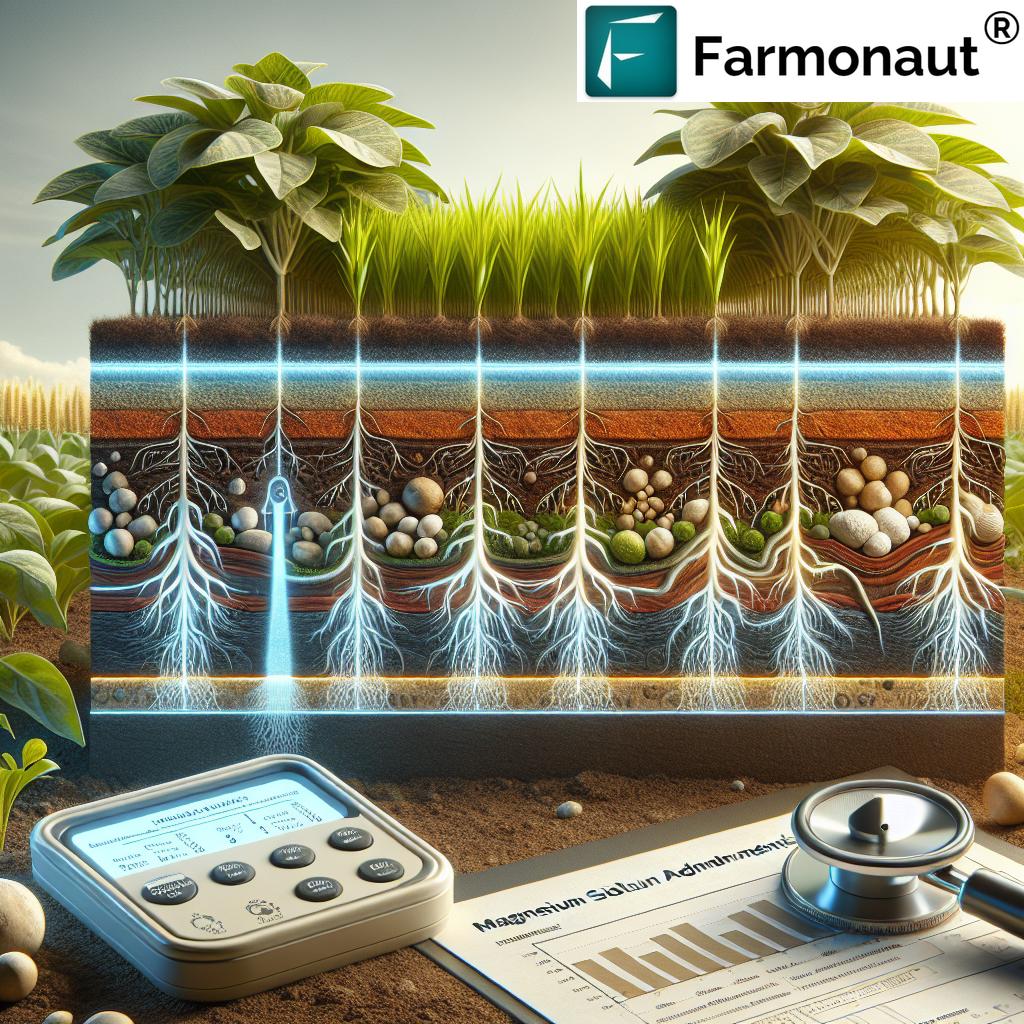Magnesium for Plants: 7 Essential Tips to Boost Growth
“80% of plant chlorophyll contains magnesium, making it vital for photosynthesis and healthy green leaves.”
Magnesium in Plant Growth: The Cornerstone of Sustainable Agronomy
Magnesium is an indispensable macronutrient in plant physiology. As we explore sustainable agriculture, we recognize that this element supports a broad spectrum of biochemical processes crucial to plant health and optimal crop yields. From its primary role as a central atom in chlorophyll molecules to its function in enzyme activation, nucleic acid stabilization, protein synthesis, and energy transfer, magnesium is a cornerstone element that directly influences our plant’s growth and resilience.
Ensuring adequate magnesium supply not only supports healthy chlorophyll synthesis and active photosynthesis, but also enhances structural integrity of cell membranes, facilitates the transport of nutrients, and enables sustainable resource utilization in soils with varying fertility levels.
What Makes Magnesium Vital for Plants?
- Central atom in chlorophyll: Magnesium acts as the core atom in chlorophyll molecules, making it essential for absorbing light energy and thus, for photosynthesis.
- Enzyme cofactor: Magnesium is a cofactor for enzymes involved in carbohydrate metabolism, protein, and nucleotide synthesis.
- Energy transfer and nucleic acid stabilization: Participates in activating ATP and stabilizing nucleic acids and ribosomes, both critical for cell growth and replication.
- Influences other nutrient absorption: From iron and phosphorus uptake to internal nutrient distribution, magnesium’s presence impacts the movement and availability of several essential nutrients.
Magnesium and Photosynthesis: Why This Nutrient Matters
One cannot overstate the role of magnesium in plant growth—especially its function in photosynthesis. As the central atom within chlorophyll, magnesium makes it possible for plants to capture sunlight and produce carbohydrates, the fuel for nearly all plant activities.
-
Chlorophyll Synthesis:
- Magnesium for chlorophyll synthesis is not optional—without it, green pigment cannot form, and photosynthetic processes grind to a halt.
- Over 80% of plant chlorophyll’s chemical structure directly incorporates magnesium.
-
Light Absorption and Conversion:
- Facilitates efficient energy transfer from sunlight, enabling plants to assimilate carbon dioxide and water into carbohydrates.
-
The Impact of Deficiency:
- Magnesium deficiency in plants results in a pale, yellow appearance and ultimately, significant reductions in growth and yield.
- Deficiency affects enzyme activation, weakening the plant’s primary metabolic pathways.
What Happens Without Enough Magnesium?
Too little magnesium disrupts the entire photosynthetic process, as magnesium is mobile and quickly depleted from older leaves to fuel new growth. This results in:
- Pale or yellowing leaves between green veins (interveinal chlorosis)
- Stunted plant growth
- Poor carbohydrate production and less robust root and fruit development
“Magnesium deficiency can reduce crop yields by up to 15%, highlighting its importance in sustainable nutrient management.”
7 Essential Tips to Identify Magnesium Deficiency Symptoms in Leaves
Detecting magnesium deficiency early is crucial for implementing timely corrective actions to safeguard plant health and yields. Here are seven essential tips to spot and understand magnesium deficiency symptoms in plants:
-
Notice Interveinal Chlorosis:
- Look for the signature yellowing of leaf tissue between the veins while the veins remain green.
- This is usually most visible on the older leaves at the base of the plant, as magnesium is a mobile nutrient.
-
Check for Leaf Curling & Necrosis:
- Observe if leaves begin curling or cupping, especially at the margins.
- Severe cases may develop necrotic spots (dead tissue) and leaf drop.
-
Assess Plant Growth and Yield:
- Stunted growth, a smaller stature and poor fruit or grain development can signal a magnesium shortage, particularly in fruiting and flowering plants.
-
Review Soil and pH Levels:
- Acidic soils (pH < 6.0) are more prone to magnesium leaching and reduced availability.
- Test soils regularly to monitor magnesium and overall nutrient levels for your crop rotation.
-
Note High Potassium or Calcium Intake:
- Excessive potassium or frequent lime (calcium) application can suppress magnesium absorption.
- Balance all nutrient inputs using soil test data to prevent competitive inhibition.
-
Monitor Rainfall and Leaching:
- High rainfall or waterlogged conditions can wash away magnesium, especially in sandy or low cation exchange capacity soils.
-
Check Plant Age & Mobility:
- Since magnesium migrates to new growth, older or lower leaves typically show deficiency first.
Magnesium Deficiency: What Do the Symptoms Look Like?
- Interveinal Chlorosis: Yellowing appears between veins, starting from older leaves and progressing upward.
- Curling, Cupping, and Necrosis: Leaves may curl at the edges, develop brown necrotic spots, and eventually drop off if not treated.
- Stunted Plants: Plants lacking magnesium grow slowly and fail to reach their normal size or yield potential.
- Reduced Carbohydrate Storage: Without magnesium’s facilitation of photosynthesis, plants store less energy and produce weaker roots and fruit.
Key Causes of Magnesium Deficiency in Plants & Corrective Measures
To manage magnesium deficiency in our fields sustainably, we must first identify its root causes and understand how various soil and environmental factors contribute to nutrient imbalances. Here’s a breakdown of the most common triggers and actionable solutions.
Main Factors Contributing to Magnesium Deficiency
- Soil Composition: Acidic (low pH), sandy soils with poor cation exchange capacity are easily depleted of magnesium through leaching.
- High Potassium Competition: Excessive potassium fertilization or poor fertilizer management may inhibit magnesium uptake by roots.
- Overuse of High-Calcium Additions: Frequent application of calcitic lime or gypsum, intended to raise soil pH, can suppress magnesium supply, especially in soils with inherently low magnesium content.
- Environmental Factors: Heavy or frequent rainfall washes away nutrients; waterlogged conditions further restrict root uptake.
Corrective Steps for Addressing Magnesium Deficiency
-
Soil Testing & Precision Monitoring:
- Utilize modern Farmonaut large-scale farm management tools or laboratory tests to assess magnesium status and soil pH.
- Monitor fields in real-time via satellite health monitoring to guide interventions.
-
Targeted Soil Amendments:
- Dolomitic Lime: Corrects both acidity and magnesium deficiency; suitable for acidic soils but may not fit every crop type.
- Epsom Salt (Magnesium Sulfate): Offers a quick fix for magnesium without affecting soil pH; ideal for foliar spray or topdressing.
- Organic Matter: Compost, cover crops, and organic mulches gently and sustainably boost magnesium over the long term.
-
Balanced Fertilization for Plants:
- Manage all inputs to avoid excessive potassium or calcium that interferes with magnesium nutrient management.
- Adjust fertilizer strategies using up-to-date soil data, and review the magnesium content of irrigation water and compost sources.
-
Optimize pH for Maximum Nutrient Availability:
- Soil pH and Magnesium Availability: Maintain pH between 6.0 and 7.0 to maximize availability for most crops, intervening with amendments only as needed.
- Use regional or field-specific pH targets for acid- or base-loving crops; monitor pH regularly.
Sustainable Magnesium Nutrient Management: Best Practices for Crop Health
Adopting sustainable magnesium nutrient management strategies helps us improve plant resilience, optimize fertilization, and safeguard the environment. Here’s how we can fortify our magnesium practices:
-
Soil Testing (Regular and Targeted):
- Schedule routine soil assessments for magnesium, potassium, and pH to guide balanced fertilization and avoid wasteful applications.
- Track magnesium status before and after crop cycles—adjust replenishment plans accordingly.
-
Fertilizer Application Timing:
- Apply magnesium soil amendments pre-planting, during side-dressing, or as foliar sprays at critical crop development stages (e.g., fruit set, major vegetative growth).
- Combine magnesium sources with organic manure or compost for slow-release benefits.
-
Use of Advanced Technology:
-
Deploy platforms like
Farmonaut Carbon Footprinting
to evaluate and reduce the environmental impact of nutrient management, promoting sustainability.
-
Deploy platforms like
-
Crop Rotation and Diversity:
- Rotate deep-rooted crops (which can access lower-soil magnesium stores) with shallow-rooted ones to optimize overall nutrient cycling.
- Varietal selection: Choose crop varieties suited to your local soil magnesium status and required pH level.
-
Organic Solutions:
- Integrate green manures, compost, and crop residues to enhance organic matter and long-term magnesium levels.
-
Farm Management Platforms:
- For real-time nutrient monitoring, Farmonaut large-scale farm management offers satellite-based crop health updates, AI advisory for soil/amendment timing, and field-specific nutrient optimization. This enables efficient, data-driven magnesium management with fewer environmental risks.
- Developers and enterprises can seamlessly integrate Farmonaut’s soil and weather data via our API—reference API Developer Docs for integration details.
Magnesium Soil Amendments—Which Should We Choose?
- Dolomitic Lime: Use in acidic soils for dual-action (pH adjustment & magnesium provision).
- Epsom Salt (Magnesium Sulfate): Preferred in neutral or alkaline soils, or for foliar applications on high-value crops. Use precise dosage to avoid sulfate buildup.
- Organic Compounds: Compost, bone meal, and certain green manures improve both soil structure and nutrient-holding capacity.
Comparative Magnesium Deficiency Symptom & Treatment Table
| Crop Type | Symptom Description | Estimated Symptom Severity | Possible Cause | Sustainable Solution |
|---|---|---|---|---|
| Wheat | Pale yellow interveinal chlorosis on older leaves, early senescence | Medium | Acidic soil with low organic matter | Apply 20-25 kg/ha Epsom salt, incorporate more compost, maintain pH 6.0-6.5 |
| Maize (Corn) | Striped interveinal yellowing, leaf tip necrosis, stunted plants | High | High potassium, sandy soil | Side-dress with magnesium sulfate, avoid high K fertilizers during peak growth |
| Tomato | Marginal interveinal chlorosis turning bronze, necrotic spots, reduced fruit quality | Medium | Over-irrigation, excessive calcium | Foliar Epsom salt spray @ 5g/L water every 2 weeks, reduce lime input |
| Soybean | Interveinal chlorosis, cupping of older leaves, poor pod set | High | Soil pH < 6.0, leaching from rainfall | Correct pH with dolomitic lime, add organic mulch for slow-release magnesium |
| Potato | Upward curling leaves, necrotic leaf edges, tuber yield loss | Medium | High rainfall, sandy soils, nutrient leaching | Magnesium sulfate application, increase soil organic matter |
Leveraging Farmonaut Technology for Magnesium Nutrient Management
To achieve long-term, effective magnesium nutrient management, we recommend integrating sustainable practices with cutting-edge technology. Farmonaut’s comprehensive platform enables precision monitoring and eco-friendly solutions for agricultural enterprises and individual farmers alike.
Key Farmonaut Capabilities for Sustainable Nutrient Management
-
Real-Time Crop Health Monitoring:
- Through satellite-based NDVI and soil moisture analytics, detect early signs of nutrient or magnesium stress before field symptoms escalate.
-
AI-Based Advisory Systems:
- Our Jeevn AI offers tailored recommendations for nutrient management, amendment scheduling, and optimal fertilization strategies.
-
Blockchain-Based Traceability:
- Ensure transparency in farm supply chains by adopting blockchain product traceability—verifying every stage from field inputs (including magnesium amendments) to harvest and sale.
-
Fleet and Resource Management:
- Streamline logistics and resource allocation for magnesium soil amendment delivery with fleet and resource management tools.
-
Crop Loan and Insurance Assistance:
- Use satellite-based verification for secure, fast access to financing—validating your farm’s health, including magnesium and nutrient management, for claims and lending.
Get started with Farmonaut’s web or mobile apps for instant crop health insights and join the movement towards more sustainable, productive agriculture.
FAQ: All About Magnesium for Plant Growth
1. What is the role of magnesium in plant growth?
Magnesium is primarily the central atom in the chlorophyll molecule, crucial for absorbing light during photosynthesis. It also acts as a cofactor for important enzymes, facilitates protein synthesis, and contributes to the stabilization of nucleic acids and ribosomes, which are essential for plant development.
2. How can I identify magnesium deficiency symptoms in leaves?
Look for interveinal chlorosis (yellowing between veins while veins remain green), leaf curling, necrotic spots, and stunted growth. Symptoms typically appear first in older leaves.
3. What causes magnesium deficiency in crops?
Common causes include acidic or sandy soils, high potassium fertilization that competes with magnesium absorption, overuse of high-calcium amendments, and environmental factors like heavy rainfall leading to leaching.
4. How can I sustainably address magnesium deficiency?
Start with regular soil testing, choosing organic amendments like compost, applying magnesium sulfate or dolomitic lime as needed, and maintaining proper pH to enhance magnesium availability.
5. Does soil pH affect magnesium absorption?
Yes, magnesium availability peaks in soils with pH 6.0 to 7.0. Acidic soils (pH below 6.0) require liming to optimize magnesium uptake, while excessive liming on already alkaline soils can reduce magnesium availability.
6. How does Farmonaut help in sustainable nutrient management?
Farmonaut offers real-time satellite-based crop health monitoring, AI-powered advisory, traceability, and resource management tools—empowering farmers and agribusinesses to implement precision, sustainable practices for nutrients like magnesium.
Summary: Sustaining Plant Health with Effective Magnesium Management
Magnesium is the backbone of healthy plant growth and sustainable crop production. As we have seen, its role expands far beyond chlorophyll formation: it catalyzes critical biochemical reactions in photosynthesis, enzyme activation, protein synthesis, and nutrient transport.
By recognizing the symptoms of magnesium deficiency in plants early, understanding the causes (including soil pH, excessive potassium or calcium inputs, and leaching), and implementing strategic magnesium soil amendments and balanced fertilization plans, we can proactively safeguard our crops, improve yields, and promote sustainability.
Leveraging technology such as Farmonaut’s satellite analytics, AI advisories, supply chain traceability, and comprehensive farm management solutions, we now have the power to optimize magnesium nutrient management across all growing zones and ensure the future of global food security. Farmonaut is dedicated to making these advanced technologies affordable, accessible, and actionable for farmers of every scale worldwide.
Use our web and mobile apps or integrate our API for science-backed, real-time guidance towards more resilient and productive farms.















